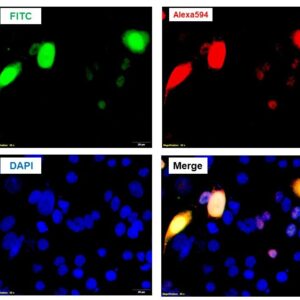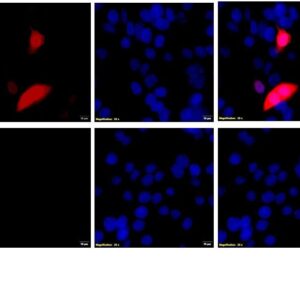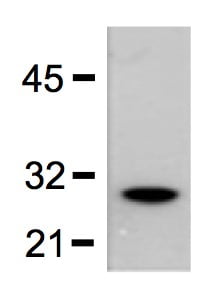| Weight | 1 lbs |
|---|---|
| Dimensions | 9 × 5 × 2 in |
| host | rabbit |
| isotype | IgG |
| clonality | polyclonal |
| concentration | 1 mg/mL |
| applications | ICC/IF, WB |
| reactivity | tagged fusion proteins |
| available sizes | 1 mg, 100 µg, 25 µg |
rabbit anti-GFP polyclonal antibody 1778
Price range: $100.00 through $2,600.00
Antibody summary
- Rabbit polyclonal to GFP
- Suitable for: WB, ICC/IF
- Reacts with: tagged fusion proteins
- Isotype: IgG
- 100 µg, 25 µg, 1 mg
rabbit anti-GFP polyclonal antibody 1778
| antibody |
|---|
| Database link: P42212 |
| Tested applications WB,ICC/IF,IHC |
| Recommended dilutions WB: 1:1000-3000 ICC/IF: 1:500-2000 For best results with other assays (e.g.: Dot, ELISA, IP, etc), please determine optimal working dilution by titration test. |
| Immunogen Recombinant GFP expressed in and purified from E. coli |
| Size and concentration 100µg and 1 mg/mL |
| Form liquid |
| Storage Instructions 2-8°C for short term, for longer term at -20°C. Avoid freeze / thaw cycles. |
| Storage buffer PBS, pH 7.2, 0.09% NaN3 |
| Purity affinity purified |
| Clonality polyclonal |
| Isotype IgG |
| Compatible secondaries goat anti-rabbit IgG, H&L chain specific, peroxidase conjugated, conjugated polyclonal antibody 9512 goat anti-rabbit IgG, H&L chain specific, biotin conjugated polyclonal antibody 2079 goat anti-rabbit IgG, H&L chain specific, FITC conjugated polyclonal antibody 7863 goat anti-rabbit IgG, H&L chain specific, Cross Absorbed polyclonal antibody 2371 goat anti-rabbit IgG, H&L chain specific, biotin conjugated polyclonal antibody, crossabsorbed 1715 goat anti-rabbit IgG, H&L chain specific, FITC conjugated polyclonal antibody, crossabsorbed 1720 |
| Isotype control Rabbit polyclonal - Isotype Control |
| target relevance |
|---|
| Protein expression of GFP and GFP tagged proteins can be checked and quantified using this antibody in Western blotting. When imaging in situ, GFP fluorescence can be amplified by this antibody when used in conjunction with a suitable fluorescent label or secondary antibody. Click for more on: epitope tags and GFP |
| Protein names Green fluorescent protein |
| Gene names GFP,GFP |
| Protein family GFP family |
| Mass 26886Da |
| Function FUNCTION: Energy-transfer acceptor. Its role is to transduce the blue chemiluminescence of the protein aequorin into green fluorescent light by energy transfer. Fluoresces in vivo upon receiving energy from the Ca(2+)-activated photoprotein aequorin. |
| Tissues TISSUE SPECIFICITY: Photocytes. |
| Structure SUBUNIT: Monomer. {ECO:0000269|PubMed:9782051}. |
| Post-translational modification PTM: Contains a chromophore consisting of modified amino acid residues. The chromophore is formed by autocatalytic backbone condensation between Ser-65 and Gly-67, and oxidation of Tyr-66 to didehydrotyrosine. Maturation of the chromophore requires nothing other than molecular oxygen. {ECO:0000269|PubMed:8448132}. |
| Biotechnology BIOTECHNOLOGY: Green fluorescent protein has been engineered to produce a vast number of variously colored mutants, fusion proteins, and biosensors. Green fluorescent protein can be mutated to emit at different wavelengths such as blue for BFP (when Tyr-66 is replaced by His), cyan for CFP (when Tyr-66 is replaced by Trp), and yellow for YFP (when Thr-203 is replaced by Tyr). Further generation of mutants led to more stable proteins (at 37 degrees Celsius for example) with brighter fluorescence and longer fluorescence lifetimes. Fluorescent proteins and their mutated allelic forms have become a useful and ubiquitous tool for making chimeric proteins, where they function as a fluorescent protein tag. Typically they tolerate N- and C-terminal fusion to a broad variety of proteins. They have been expressed in most known cell types and are used as a noninvasive fluorescent marker in living cells and organisms. They enable a wide range of applications where they have functioned as a cell lineage tracer, reporter of gene expression, or as a measure of protein-protein interactions (PubMed:17685514, PubMed:17685554, PubMed:8578587, PubMed:8707053, PubMed:9145105, PubMed:9154981, PubMed:9759496, PubMed:9782051). Can also be used as a molecular thermometer, allowing accurate temperature measurements in fluids. The measurement process relies on the detection of the blinking of GFP using fluorescence correlation spectroscopy (PubMed:17685514). {ECO:0000269|PubMed:17685514, ECO:0000269|PubMed:17685554, ECO:0000269|PubMed:8578587, ECO:0000269|PubMed:8707053, ECO:0000269|PubMed:9145105, ECO:0000269|PubMed:9154981, ECO:0000269|PubMed:9759496, ECO:0000269|PubMed:9782051}. |
| Target Relevance information above includes information from UniProt accession: P42212 |
| The UniProt Consortium |
Publications
| pmid | title | authors | citation |
|---|---|---|---|
| We haven't added any publications to our database yet. | |||
Protocols
| relevant to this product |
|---|
| Western blot IHC ICC |
Documents
| # | SDS | Certificate | |
|---|---|---|---|
| Please enter your product and batch number here to retrieve product datasheet, SDS, and QC information. | |||
Only logged in customers who have purchased this product may leave a review.


















Reviews
There are no reviews yet.